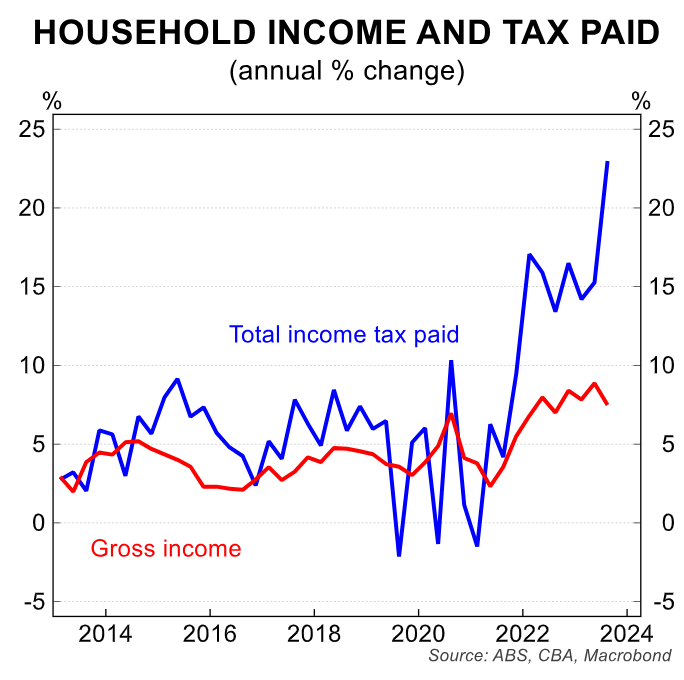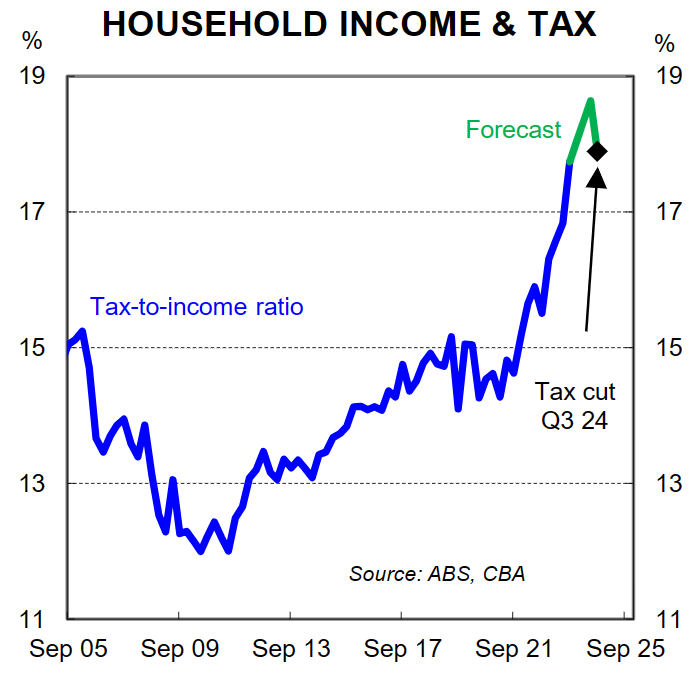CBA’s analysis of the Stage 3 tax cuts revealed how much money Australians are losing due to personal income taxes.
As seen in the following CBA chart, the quarterly amount of income tax payable increased by a remarkable 23.4% in the fiscal year ending September 2023 (latest available data).
However, overall household income increased by only 7.5% throughout the same period.

The gap between tax paid and incomes meant the share of aggregate household income lost in personal taxes rose to an equal record high in September 2023.
To make matters worse, even after the Stage 3 tax cuts are implemented, the share of income lost to personal taxes is expected to climb in Q3 2024, and will continue to rise as inflation forces people into higher tax rates (i.e. “bracket creep”).

Modelling by Australian National University (ANU) associate professor Ben Phillips suggests that the federal government’s changes to the Stage 3 income tax cuts will result in 86% of Australians receiving a bigger tax cut in 2024-25.
However, 23% (nearly 3.6 million) will pay more tax in 2033-34 compared with the original version of the Stage 3.
Professor Phillips gave an important caveat to the ANU analysis, stating that the calculations anticipated no change in the tax structure over the medium term, “which would be historically unusual”.
Warren Hogan, chief economic consultant at Judo Bank, said the ANU statistics sounded “about right”.
He said the Stage 3 redesign strengthened the case for the government to act more quickly to address bracket creep than would have been the case under the previously legislated tax cuts, which would have introduced a flat 30% tax rate for those earning between $45,000 and $200,000 beginning 1 July.
“If they are serious about addressing bracket creep for all Australians they shouldn’t have done the changes”, Hogan said.
“But they will have to do something in the next couple of years”.
“If you want to have a meaningful negation of the bracket creep we are starting to see in the last few years, you need to do something now. They have chosen not to”.
Regardless of your view of the Stage 3 tax cuts, it is unsustainable, inefficient, and inequitable to have Australia’s tax system so reliant on a diminishing share of workers while the proportion of taxes collected via indirect sources (e.g., GST and fuel excise) declines.
This is especially true given that the older age cohort of Australians is growing in size and paying less tax than ever before, despite owning the vast majority of the country’s wealth.
Australia urgently needs comprehensive tax reform that shifts the tax base away from productive effort (taxing work) and towards more efficient sources such as resources, land, and consumption.

